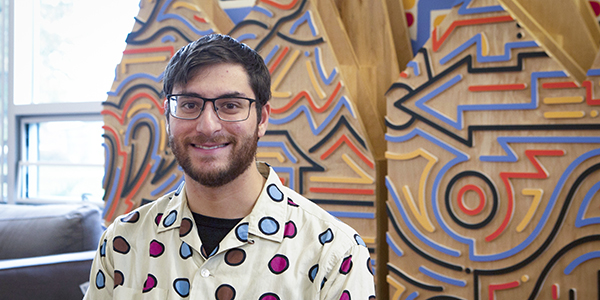Putting community meals on the map
How one geography student turned asset mapping into a community resource

When Ben Levine, a first-year graduate student studying geography, began a tutoring internship as an undergraduate, he had no idea it would inspire an even larger project.
In his time at Binghamton University, Levine has been working on a number of local and upstate New York issues, such as food insecurity and environmental health. Originally from the St. Louis, Mo., area, Levine calls Binghamton his adopted home and his love for both the city and its people is reflected in his idea to create and distribute a map of free community meals for students and others facing food insecurity.
Levine said students can just show up to these meals — no student ID or wallet is necessary because all meals are free.
“Attending community meals is a good way to relieve food insecurity,” said Levine. “It can also be an opportunity to interact with local religious and indigent communities.”
According to the American Community Survey (ACS), in 2017, 33.3% of Binghamton residents lived below the poverty line, compared to the national average of 13.4%. Community meals are a free resource to mitigate some of the stressors for those living in poverty.
Levine joked that he is still “gobsmacked” by how far this project has come, given how the idea originated.
“It came together in different stages,” he said. “In the summer of 2018, I did an internship with Broome County HEARS (Higher Education Access, Retention, Success). I was tutoring someone at the Broome County Library, and one day the student didn’t show up, so I started talking to a man who was in that area of the library. A few months later I ran into him at Confluence Park, and he said that he was going to a community meal at First Assembly of God and asked if I wanted to join him.”
According to Levine, attending this meal inspired him to get more involved with local outreach for the poor and the homeless. This inspiration solidified when a few months later, a homeless couple asked Levine for directions to a meal whose address wasn’t completely clear. Levine then knew he wanted to make a map distinctly marking each location where community meals are available — a type of asset mapping.
“It’s conveying graphically what’s available in a community, such as services, parks, landmarks, libraries and nonprofits,” Levine said. “Services can often be fragmented because they function in different parts of an area. There are many layers, and I think that asset mapping helps to streamline access to important local resources.”
“The food map created by Mr. Levine is an incredible tool that guides students to where they can find a free meal any day of the week,” said Milton Chester, assistant dean for Off Campus Services and Programs. “But what I’m most impressed with is that Mr. Levine saw a problem and took the initiative to address it without being prompted by anyone. He took the skills and knowledge he learned in the classroom and applied it to a real-life problem.”
However, community meals aren’t just a resource for food. “There are people who go to these meals who are there for a religious purpose,” Levine said. “There’s also a fair amount of elderly residents who go to these meals for the social support. Eating together, I believe, is a really great thing.”
The work doesn’t stop here for Levine. He is currently continuing his research on food relief in Broome County and plans to expand his map to locations outside of the urban core.
“These are only about 75% of the community meals in Broome County,” Levine said. “There are ones in Endicott, Endwell, Vestal, Deposit, Kirkwood and Whitney Point, so I want to go to all of those in the next couple of weeks and put those on the map, too.”
Check out the weekly free meal schedule and the map guide for each location.
